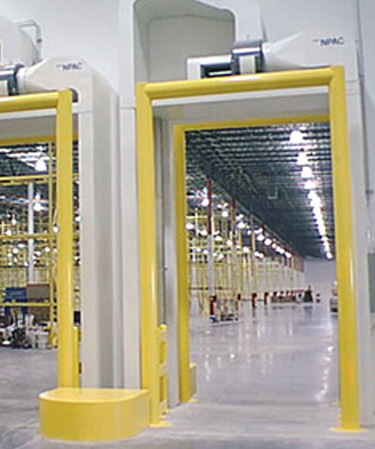Model NPAC Negative Pressure Air Curtain
Certainly! The Model NPAC, or Negative Pressure Air Curtain, is a technology used in various industries to control airflow and maintain specific pressure differentials between two areas. This system is typically designed to create a lower pressure environment on one side of a barrier or door and a higher pressure environment on the other side.
Certainly! The Model NPAC, or Negative Pressure Air Curtain, is a technology used in various industries to control airflow and maintain specific pressure differentials between two areas. This system is typically designed to create a lower pressure environment on one side of a barrier or door and a higher pressure environment on the other side.
Here are some key points about the Model NPAC:
Purpose: The primary purpose of a Negative Pressure Air Curtain is to prevent the migration of contaminants, such as dust, airborne particles, odors, or pathogens, from one area to another. It’s often used in applications where maintaining a clean or controlled environment is crucial, like in pharmaceutical manufacturing, healthcare facilities, laboratories, or cleanrooms.
How it Works: The NPAC system uses fans and air pressure differentials to create a barrier of air that flows from the clean or controlled side to the contaminated side. This airflow prevents contaminants from crossing over, as they would be pushed back by the higher pressure on the clean side.
Components: A typical NPAC system includes fans, ductwork, and sensors to monitor pressure differentials. It may also incorporate air filters to ensure that the air on the clean side remains uncontaminated.
The Model NPAC, or Negative Pressure Air Curtain, is a valuable technology used to maintain controlled environments by creating pressure differentials that prevent the transfer of contaminants between two areas. It finds applications in industries where maintaining cleanliness and preventing contamination is of utmost importance.
Model NPAC Negative Pressure Air Curtain Benefits
Supply where indicated on plans HCR Model NPAC Air Door for doorways with low temperature differentials and or for temperatures above freezing.
Air Door to be powder coated cold-rolled steel. Powder coating meets 500 hour salt spray test.
NEMA 1 Power/control panel complete. Model NPAC equipment cabinet houses the centrifugal fan, fan motor, fan drive components, and prewired electrical components. Service door(s) are provide, if required, to allow access to all internal components. Motor is controlled by VFD (Variable Frequency Drive). Single point electrical connection.
Air Door to have two side plenums: one with discharge nozzle, the other with an intake.
Discharge nozzle is easily adjustable to maximize air block. Air volume adjustment mechanisms are easily accessible without removing any covers or secondary openings.
Unit can be mounted on either side of wall. Depending on temperature differential insulation cladding may be required.
Air Door assembly is structurally self supporting. All hardware has protective coating against corrosion.
Air Door power to be 208, 240, or 480 volt AC, 60 Hertz, 3 phase. Visible signal light to show when motor is not running. Complete door assembly to be ready for connection to power. (Architect to designate responsibility for field wiring.)
• Metal cladding can be stainless steel or cold-rolled steel powder coated to custom color.
• ‘Clean outs’ can be added where needed.
• Complete NEMA 3, 4, 4x, 4x stainless, or 12 requirements.
• Hot Gas Coil instead of resistive heat.
• Custom standoff panels with trim to interconnect to night doors or existing doors.
• HCR Air Door to be used in conjunction with existing or new door to form a Hybrid solution.
These doors can include all types of insulated roll up doors, double curtain roll up doors, hard insulated automatic doors that slide either horizontally or vertically, or insulated sliding mattress type doors.
1. What factors determine the choice of door solution for an application?
Some of the important factors determining the door type recommendation are the temperature difference across the doorway, opening size, traffic rates, safety concerns, convenience, maintenance, building pressure imbalance, energy savings and etc…
2. Where are HCR air doors made?
HCR air doors are manufactured in Montana, USA.
3. What is the biggest doorway opening size that can be fitted with an HCR air door?
Openings of 14-ft wide and 20-ft high are maximum width and height dimensions that can be fitted with an HCR air door.
4. Which side of the doorway should the HCR air door get installed?
HCR air doors can be installed on either side of the doorway for single air curtains whereas the double and triple air curtain units could also be split mounted. Single air curtains can also be custom designed for doorway jamb mounting.
5. What is an HCR NPAC air curtain?
Negative Pressure Air Curtains are designed for doorways that show pressure imbalance across the opening.
6. What is an “HCR Doorway Survey” form?
An HCR Doorway Survey form is a one page customer completed form summarizing key physical, thermal/environmental, usage and customer desired features of a specific doorway.
Contact BMP Doors Canada
If you have a specific request, a special project in mind, or require detailed specifications for our comprehensive range of high-speed roll-up curtain door applications, our team is fully prepared to address your inquiries.


